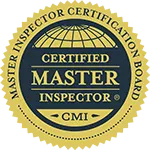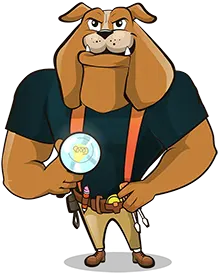5-Point Major-Items Inspection
If It’s Got Good Bones, It’s A Good House
Table of Contents
- Not Sure? ➡ Take Our 3-Question Quiz
- What Is A 5-Point Major-Items Inspection?
- The 5 Major Areas of Every Home
- Sample Major-Item Inspection Reports
- Meet Steve – Your Major-Items Home Inspector
- This Month’s Featured Major-Items Inspection
- Why Did This Customer Choose Bulldog?
- Major-Items Inspection Guidelines
- Major-Item Inspection Gallery
- Frequently Asked Questions
Not Sure? ➡ Take Our 3-Question Quiz
What Is A 5-Point Major-Items Inspection?
It is the inspection of ONLY the 5 major areas of a home:
- Foundation
- Plumbing
- Roof
- Electrical
- HVAC System
- No lights
- No switches
- No outlets
- No windows
- No doors
- No interior walls
- No minor maintenance items
ONLY the costly, intrusive, structural, and meaty parts.
These 5 areas are responsible for 80% of all major defects that snag or kill all real estate deals when things go wrong.
Who Is It For?
A 5-point major-items inspection is for the bare-bones buyer or real estate investor who is NOT interested in anything other than the condition of the 5 major areas listed above.
Whether you know enough to NOT be concerned, you’re buying the property as-is, funds are tight, or it’s a major rehab where most things will get replaced, all that matters to you is THE BONES.
How Is This Different From A Full Inspection?
These 5 areas are responsible for 80% of the reasons homebuyers change their minds and WALK AWAY from a home they may have loved just 5 minutes before.
Why Does It Work?
Vilfredo Pareto said it best.
He was the Italian economist and polymath who created the Pareto Principle (aka the 80/20 rule) in 1906.

It was first used to describe the distribution of land ownership and wealth in Italy but later became the rule for cause-and-effect outcomes. It simply means that 80% of a result comes from only 20% of the action taken to get that result.
For a home inspection, this means 20% of a home creates 80% of the reasons buyers walk away.
And our 5-point major-items inspection exploits this to your advantage.
You see, over the years I’ve personally witnessed the same 5 areas play a disproportionately large role in the untimely demise of countless deals – NO matter how big or how old the home.
And the major areas NEVER change:
The 5 Major Areas of Every Home
1. Foundation
What Is Inspected:
Type
Sub-floor
Material
Columns
Cracking
Seepage
Floor
Exterior Foundation
Joists
Posts
Interior Foundation
Beams
Posts
Movement
Ceiling
Smoke detector
2. Plumbing
What Is Inspected:
Water supply
Sump pump
Main Valve
Venting
Water lines
Gas lines
Water heater
Drain lines
Run water the entire inspection (if vacant)
3. Roof
What Is Inspected:
Roof
Gutters
Downspouts
Skylights
Ventilation
Chimneys
Penetrations
Shingles
Flashings
Soffits
Fascias
Attic
Framing
Ventilation
Fans
Attic access
Insulation
Exhaust
Skylights
Chimneys
Penetrations
Wiring
4. Electrical
What Is Inspected:
Service entrance
Grounding
Circuit wiring
Distribution panel
Sub-panel
5. HVAC
What Is Inspected:
Heating
Controls
Air distribution
Heat sources
CO detector
Chimneys
Flues
Vents
Cooling
Type of system
Air distribution
Refrigerant lines
Evaporator
Condenser
Temp. Differential
Click here for more about a home’s HVAC system.
Sample Major-Item Inspection Reports
Check out the sample major-item home inspection reports below:
Sample 5-Point Home Inspection Report of 5-Year-Old Home
Sample 5-Point Home Inspection Report of 45-Year-Old HomeHome
Sample 5-Point Home Inspection Report of 112-Year-Old Home
Meet Steve – Your Major-Items Home Inspector
Award-Winning local Certified Master Inspector® Steve Rodriguez explains the Bulldog difference:
“There’s more to a major-items inspection than just checking for problems. It’s also about communicating those problems in a way YOU understand.
And not just today. Your home inspection report should be easy to understand for years to come.”
This Month’s Featured Major-Items Inspection
No matter what anyone says, old homes are great – especially if you’re a real estate investor: there’s lots of charm, craftsmanship, and the building materials were almost always better than anything we can get today. At least when we’re talking about the wood.
But foundations were usually block or stone. And both are weaker than modern day poured concrete.
So when everything else looks like its full speed ahead, a bad foundation can rise up and bring the whole deal crashing down.
That’s what happened with this home. The inspection uncovered shifting blocks and horizontal cracking in the crawlspace that would take big bucks to fix.
The funny thing is, these were easy for anyone to spot if they only knew what to look for.
Here are the photos from this inspection:

click below to see the photos
Click here to see this month’s featured full home inspection
Why Did This Customer Choose Bulldog?
Tyler was a no-nonsense first-time homebuyer who interviewed a few home inspectors before finally choosing us.
When it was over, we only asked him 3 questions:
1. What do you think about our service?
2. Which services did you order?
3. Would you recommend us to others?
This is what he said.
Major-Items Inspection Guidelines
Because this is such an efficient and laser-focused home inspection, the conditions that make the major-items inspection work are simple but crucial.
#1 – All utilities MUST be on and all pilot lights lit.
This includes
- Water (most important)
- Electricity
- Gas
#2 – Water MUST be flowing through the faucets when we get there.
We DO NOT open the water main valve or the street shutoff valve.
Too many times the person giving permission to turn on the water is NOT the same person who turned it off.
That’s why we’ve seen our fair share of unexpected (and sometimes dramatic) situations that could have been avoided with a little preparation.
All we ask is that all reasonable effort be made to ensure the water is NOT just on, but FLOWING through the faucets when we arrive for the inspection.
This NOT ONLY ensures the water lines are turned on by the person responsible, but:
- Speeds up repairs (any leaks will be found by the owner or their representative)
- Saves you time (you won’t be setting aside time for an inspection that won’t happen + rescheduling for another day + losing time in your inspection period)
- Saves you the stress (you don’t want to watch water damage unfold)
- Avoids confusion (with the homeowner or management company over what happened and why)
- Keeps you from buying a home with new and unnecessary water damage (that you know should have been avoided)
- Keeps negotiations from getting sticky (especially, if you’re being forced to buy the property in ‘as-is’ condition)
Thanks for understanding and helping us give you the best – and most efficient – major-items inspection possible!
Major-Item Inspection Gallery
Click here to see our gallery of full home inspections
Frequently Asked Questions
The average time for a major-items inspection is about an hour.
No. Unlike the full home inspection, our major-items inspection does not include the termite inspection.
The major-items inspection is an ala carte service based on the needs of real estate investors who want to pick and choose their inspection services.
But it can be ordered separately.
The answer depends on what you want and need.
Yes.
But it doesn’t replace a professional home inspection. It only helps you look at the bones to find the obvious deal breakers that would scare you away BEFORE you call a pro.
And it’s based on our major-items inspection.
Click here to learn more about our DIY 30 min. home inspection checklist.
Your home inspection report will always be ready the same day and gets delivered after payment is made.
We accept:
- Visa
- Mastercard
- Check
- Money order
- Cash
No. Payment is required to receive your report.
Yes, of course.
A successful home inspection depends on your level of understanding not will not only increase your level of understanding, it will reduce help you make better decisions later.
Yes. I encourage you to do whatever makes you feel comfortable.
But keep in mind that distractions (including loud nearby conversations) will interfere with concentration and thus diminish the quality of the very service you’re investing in me to provide.
Yes. Absolutely. But questions should be asked before the inspection starts or saved for the end when more definite answers can be given.
Great question. Yes.
▶ Take notes and jot down questions.
▶ Send anything strange or confusing to your home inspector before the home inspection.
▶ Know your budget and expectations for the home
▶ Try to attend. There’s nothing better than hearing and seeing the outcome firsthand.
▶ Hold your questions until the end and don’t distract your home inspector while he’s working. You’re free to follow and observe, but questions and loud conversations within earshot are counterproductive.
All your questions will get answered when it’s over.
Congratulations on your new home!





































































